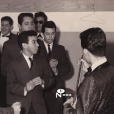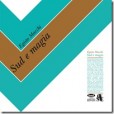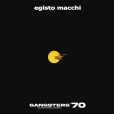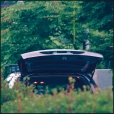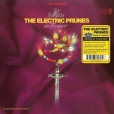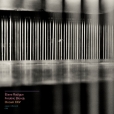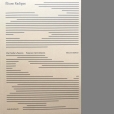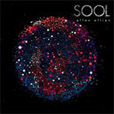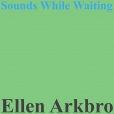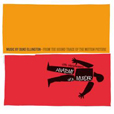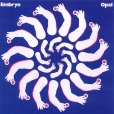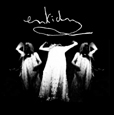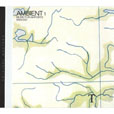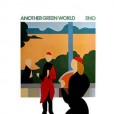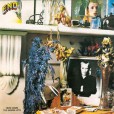Your basket is empty

An anti-war collage of words and sounds from August 6, 1966, including contributions from a plastic clock-radio, The Velvet Underground, Gerard Malanga, Marion Brown, Allen Ginsberg, Ishmael Reed, Andy Warhol (standing around silently) and Ed Sanders.
‘Venomous Tex-Mex R&B and early rock n’roll from San Antonio’s West Side scene. From 1961-67, Bexar county kingmaker Abe Epstein cut every teen combo to grace the Patio Andaluz stage, launching the careers of Doug Sahm, The Royal Jesters, Sonny Ace, The Dreamliners, and hundreds more throughout the decade.’
Ed Sanders founded a magazine called Fuck You (in 1962), a radical bookshop on the Lower East Side of NYC, named Peace Eye, and The Fugs.
This is a kind of incantatory left-anarchist history lesson, with interjections on a small keyboard called a pulse lyre, which he invented and built himself. It’s droll, epic, engaging, stirring; warmly recommended.
Presented in a beautiful gatefold sleeve, with lyric sheet.
‘Many mayhemic forces were set against the socialist zone…’
Created in collaboration with Walter Branchi from the Gruppo di Improvvisazione Nuova Consonanza, this soundtrack to Mino Guerrini’s 1968 film is among the most strikingly experimental of all Macchi’s music for cinema. A suspenseful, jet-propelled fresh mix of
psychedelia, jazz, and improv, threaded with beautiful melodies.
The first time out; from the master tapes.
Crucial, preposterous David Axelrod!
Composed and arranged by the maestro, a psychedelic garage-rock opera, sung in Latin, with Gregorian chant, pipe organ, lashings of fuzz guitar, strings and horns.
A version of the opener Kyrie Eleison famously featured in the soundtrack for Easy Rider, accompanying several scenes.
This definitive reissue was mastered by Kevin Gray using the original tapes.
This stylish, devoted, two-hundred-plus-page book is based around a deep, fascinating interview, covering the work in detail, but with naturalness and directness; also Radigue’s life, milieux, aesthetics and methods, politics, and so on. There are numerous choice photos; a few precious sketches, flyers and diagrams. The oeuvre is listed, with commentaries. All texts are in both English and French, beginning with her prose poem The Mysterious Power of the Infinitesimal. Pretty much indispensable, if you’re at all interested.
‘Eliane Radigue and I decided to resume our conversation and come up with this expanded second edition of the book. Much had happened since the first edition that deserved to be explored in more depth, in particular the development of the Occam Ocean cycle. But I also took the opportunity to ask her questions about her earlier work that had not been addressed previously. The first four parts of this new edition remain unchanged, but they are now followed by an epilogue. The lists of works and publications have also been updated and extended’ (Julia Eckhardt, December 2023).
Captivatingly austere, minimal, deconstructed, but deft and in a way intimate.
‘These recordings are traces of something I have come to love to do in large resonant spaces, which is to set up sustained chords on multiple organs and then move slowly through the sound. The instruments are usually far apart, which makes for the emergence of large fields of continuous change, spaces of harmonicity that can be passed through layer by layer and which contain within them points of both clarity and overwhelming complexity. The organ pipes are tuned and retuned, though sometimes I leave them just as they are. What I’m searching for is the moment when a particular kind of sounding texturality is revealed – it is rough, focused and yet strangely transparent.’
Plenty of thrills and spills in this soundtrack to Otto Preminger’s 1959 film. Steeply evocative dynamic and rhythmic contrasts and quick changes in orchestral density get the job done — with a repeated strain of melody — and make for highly entertaining listening, with numerous rollicking brass passages in amongst the piano-threaded impressionism, plus terrific soloing by Johnny Hodges, Ray Nance and co. Highlights include the suspenseful opener, the moody Midnight Indigo, the sublimely sad Almost Cried, and the band hard-rocking out-the-door with Upper And Outest, culminating in an amazing stratospheric passage by Cat Anderson, playing for a moment as if the needle is stuck.
Check out the opening of the film, with its title sequence by Saul Bass, and Duke’s music. Class.
Not for the faint-hearted — dark and dirty psych improv from Chie Mukai, Eric Cordier and Seichi Yamamoto (Boredoms). Moody, subterranean squalls and drones, blowing up like a bad-tempered Fushitsusha.
With Eno more the guiding hand for this second collaboration with Cluster. Open, airy, ambient, unhurried. Originally released in 1978, but still fresh (except for Eno’s singing).

